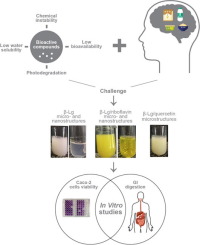Food Research International ( IF 7.0 ) Pub Date : 2020-01-07 , DOI: 10.1016/j.foodres.2020.108979 Lívia S. Simões , Joana T. Martins , Ana C. Pinheiro , António A. Vicente , Oscar L. Ramos

|
β-Lactoglobulin (β-Lg) is known to be capable to bind hydrophilic and hydrophobic bioactive compounds. This research aimed to assess the in vitro performance of β-Lg micro- (diameter ranging from 200 to 300 nm) and nano (diameter < 100 nm) structures associated to hydrophilic and hydrophobic model compounds on Caco-2 cells and under simulated gastrointestinal (GI) conditions. Riboflavin and quercetin were studied as hydrophilic and hydrophobic model compounds, respectively. Cytotoxicity experiment was conducted using in vitro cellular model based on human colon carcinoma Caco-2 cells. Moreover, the digestion process was simulated using the harmonized INFOGEST in vitro digestion model, where samples were taken at each phase of digestion process - oral, gastric and intestinal - and characterized in terms of particle size, polydispersity index (PDI), surface charge by dynamic light scattering (DLS); protein hydrolysis degree by 2,4,6-trinitrobenzene sulfonic acid (TNBSA) assay and native polyacrylamide gel electrophoresis; and bioactive compound concentration. Caco-2 cell viability was not affected up to 21 x 10-3 mg mL-1 of riboflavin and 16 x 10-3 mg mL-1 quercetin on β-Lg micro- and nanostructures. In the oral phase, β-Lg structures’ particle size, PDI and surface charge values were not changed comparing to the initial β-Lg structures (i.e., before being subjected to in vitro GI digestion). During gastric digestion, β-Lg structures were resistant to proteolytic enzymes and to acid environment of the stomach – confirmed by TNBSA and native gel electrophoresis. In vitro digestion results indicated that β-Lg micro- and nanostructures protected both hydrophilic and hydrophobic compounds from gastric conditions and deliver them to target site (i.e., intestinal phase). In addition, β-Lg structures were capable to enhance riboflavin and quercetin bioaccessibility and bioavailability potential compared to bioactive compounds in their free form. This study indicated that β-Lg micro- and nanostructures were capable to enhance hydrophilic and hydrophobic compounds bioavailability potential and they can be used as oral delivery systems.
中文翻译:

β-乳球蛋白的微结构和纳米结构作为生物活性化合物的载体:体外研究
已知β-乳球蛋白(β-Lg)能够结合亲水性和疏水性生物活性化合物。这项研究旨在评估与亲水和疏水模型化合物相关的β-Lg微结构(直径范围为200至300 nm)和纳米结构(直径<100 nm)在Caco-2细胞和模拟胃肠道下的体外性能( GI)条件。核黄素和槲皮素分别作为亲水和疏水模型化合物进行了研究。使用基于人结肠癌Caco-2细胞的体外细胞模型进行细胞毒性实验。此外,使用协调的INFOGEST在体外模拟了消化过程消化模型,在消化过程的每个阶段(口腔,胃和肠)取样,并通过粒度,多分散指数(PDI),动态光散射(DLS)产生的表面电荷进行表征;通过2,4,6-三硝基苯磺酸(TNBSA)测定和天然聚丙烯酰胺凝胶电泳测定蛋白质的水解度;和生物活性化合物的浓度。在β-Lg的微结构和纳米结构上,多达21 x 10 -3 mg mL -1的核黄素和16 x 10 -3 mg mL -1的槲皮素对Caco-2细胞的活力没有影响。在口服阶段,β-Lg结构的粒径,PDI和表面电荷值与初始β-Lg结构相比(即,在进行体外试验之前)没有变化胃肠消化)。在胃消化过程中,β-Lg结构对蛋白水解酶和胃的酸性环境具有抵抗力-通过TNBSA和天然凝胶电泳证实。体外消化结果表明,β-Lg的微结构和纳米结构可保护亲水性和疏水性化合物免受胃部疾病的侵害,并将其递送至靶位点(即肠相)。此外,与游离形式的生物活性化合物相比,β-Lg结构能够增强核黄素和槲皮素的生物利用度和生物利用度潜力。这项研究表明,β-Lg的微结构和纳米结构能够增强亲水性和疏水性化合物的生物利用度潜力,它们可用作口服给药系统。











































 京公网安备 11010802027423号
京公网安备 11010802027423号